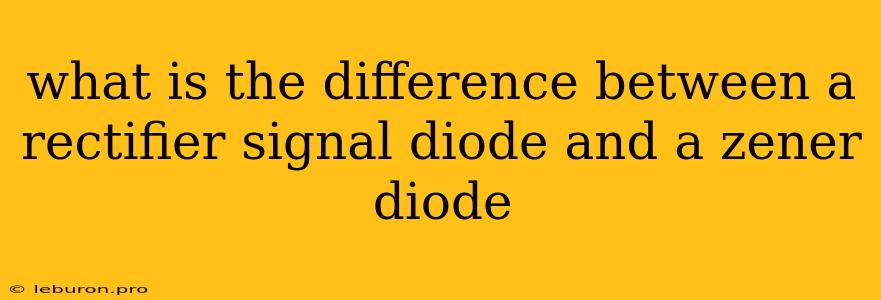Understanding the Differences Between Rectifier Signal Diodes and Zener Diodes
Diodes are semiconductor devices that play a crucial role in various electronic circuits. They are essentially one-way gates for electrical current, allowing it to flow in one direction while blocking it in the other. However, within this broad category of diodes, there exist various types with specific characteristics and functions. Two prominent examples are rectifier signal diodes and zener diodes, each serving distinct purposes in electronic applications. While both are essential components, understanding their differences is crucial for efficient circuit design and troubleshooting.
Rectifier Signal Diodes: The Foundation of AC-to-DC Conversion
Rectifier signal diodes are the workhorses of AC-to-DC conversion. Their primary function is to allow current flow in only one direction, effectively converting alternating current (AC) into direct current (DC). This is achieved by utilizing the diode's forward bias characteristic, where it offers low resistance to current flow in the forward direction (positive to negative terminal). In the reverse direction, the diode exhibits high resistance, effectively blocking current flow.
Working Principle of Rectifier Signal Diodes
When an AC signal is applied across a rectifier diode, during the positive half-cycle of the input waveform, the diode is forward-biased, allowing current to flow. During the negative half-cycle, the diode becomes reverse-biased, blocking current flow. This results in a pulsating DC output, which can be further smoothed out using a capacitor.
Applications of Rectifier Signal Diodes
Rectifier signal diodes are commonly used in a wide range of applications, including:
- Power supplies: Converting AC power from the mains to DC power for electronic devices.
- Battery chargers: Charging batteries by converting AC to DC.
- Radio receivers: Detecting radio signals and converting them to audio signals.
- Inverters: Converting DC to AC for various applications.
Zener Diodes: Regulating Voltage with Precision
Unlike rectifier signal diodes, zener diodes are designed to operate in the reverse breakdown region. This means that instead of blocking current flow in the reverse direction, they allow a controlled amount of current to flow when a specific reverse voltage, known as the zener voltage, is applied.
Working Principle of Zener Diodes
When a reverse voltage is applied across a zener diode, it remains in the reverse bias region until the voltage reaches the zener breakdown voltage. At this point, the diode enters the breakdown region and allows a controlled amount of current to flow. The voltage across the diode remains relatively constant at the zener voltage even if the input voltage fluctuates.
Applications of Zener Diodes
Zener diodes are widely used in electronic circuits for various purposes, including:
- Voltage regulation: Maintaining a stable output voltage despite fluctuations in the input voltage.
- Overvoltage protection: Preventing sensitive components from being damaged by excessive voltage.
- Reference voltage: Providing a stable voltage reference for other circuits.
- Clipping circuits: Limiting the voltage swings of a signal.
Key Differences Between Rectifier Signal Diodes and Zener Diodes
While both rectifier signal diodes and zener diodes are essential components in electronic circuits, they differ in their operation and applications. Here's a table summarizing their key differences:
| Feature | Rectifier Signal Diode | Zener Diode |
|---|---|---|
| Operating Region | Forward bias | Reverse bias (breakdown region) |
| Current Flow | Unidirectional | Bidirectional (controlled in breakdown region) |
| Voltage Characteristics | Allows current flow in forward direction | Maintains constant voltage at zener breakdown voltage |
| Application | AC-to-DC conversion | Voltage regulation, overvoltage protection, reference voltage |
Conclusion
Rectifier signal diodes and zener diodes, despite being both types of diodes, exhibit distinct characteristics and serve distinct functions in electronic circuits. Rectifier signal diodes are primarily used for converting AC to DC, while zener diodes excel in voltage regulation, overvoltage protection, and reference voltage applications. Understanding the differences between these two types of diodes is crucial for designing and troubleshooting electronic circuits efficiently. By utilizing the right type of diode for the specific application, engineers can ensure optimal circuit performance and reliability.
